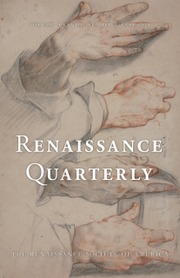In this valuable book the editors note that research on the “dialogue” (5) between the visual and the literary fields in the study of early modern religion has lately broadened into media beyond the illuminated manuscripts and printed books encountered in the “classic iconographic analysis” (5) practiced by Erwin Panofsky and his followers. Today, diversifying “methodological requirements” (6) must direct attention to “the specific modes of expression and enunciation of each medium” to the “discursive expressivity of images” (5). The book’s historiographic review of image/text methodology from the 1970s to the present displays a range of theoretical models from several disciplines, many exemplified in the select studies. It is reassuring to see these scholars enriching their art historical inquiries with uncommon theoretical skills.
Ingrid Falque’s “Framing the Text-Image Relationship in Henry Suso’s Exemplar” explores in the Dominican’s tract the absence of frames or borders, working against the familiar paradigm for reading text/image interaction. Here those relationships are “close and open at the same time” (21). Frame and framing concepts expose the “complex intermedial construction” (22) at work. “The text acts as a framing device” (27) guiding the interpretation of the images. Kees Schepers’s “How to Read the Drawings of Gielis vander Hecken (1491–1538)” studies the canon’s illustrated Labirinthi with thirty-three full-page drawings employing “textual and visual allegory and typology” (47). Explanatory Latin verses are depicted, but these scarcely suffice to clarify complex imagery of interlocking human forms, geometrical constructions, and inscriptions. Schepers examines the “diagrammatic” and “story-telling” (49) drawings, suggesting links with liturgical texts. Grégory Ems’s “The Adventures of the Soul in a Wonderful Emblematic Manuscript of the Belgium Royal Library” studies an emblematic booklet from seventeenth-century Antwerp. The composite nature of “anagrams, rebus and emblems…implies a fragmented reading” (83) in both Latin and Dutch. The intricate pictures “at the center of each text” are unusual in a “meditative manuscript” (85). For Ems, “the ideas radiate from the picture, which serves as a…hub linking all the textual components”—an example of “iconotextuality” (108).
Walter S. Melion’s “Sese oblectari in dies: Tropes of Materiality and Artisanship in the Paradisus precum selectarum (1610) of the Cistercian Sub-prior Martin Boschman” explicates the monk’s “personalized prayers and spiritual exercises” (111), displaying 221 engravings. Melion perceives the manuscript as “complementing the Tridentine breviary and missal,” and fitting “the daily regimen of a Cistercian” (112). He cleverly describes the “materiality” of the manuscript’s formation: “Printing, pasting or engraving is compared to the spiritual exercises of impressing, affixing, or incising the heart with the image of Christ” (113). Material processes are “troped” by “paronomastic references embedded in the prayers” (113). Elliott D. Wise, in “Hidden Sons: Baptism, and Vernacular Mysticism in Rogier van der Weyden’s St. John Triptych,” not dismissing the interpretive authority of Latin texts, turns to vernacular devotional texts, arguing that their distinctive visual imagery deserves concentrated attention. Isolating the mystical texts of canon Jan van Ruusbroec (1293–1381), Wise analyzes Rogier’s triptych, establishing that Ruusbroec possessed theological weight for the Carthusians, who disseminated his work. Rogier was at once a benefactor and reader of their spiritual tracts.
Anna Dlabačová’s “The Art of Observance. Jan Provoost’s Diptych of a Franciscan Friar as an Exponent of the Spirituality and Position of the Franciscan Order in the Low Countries, c. 1520” reads the diptych as a “spiritual instrument” (214) of the Observance. Dlabačová interrogates iconographic and material particularities in the theme of death—that of Christ and of the sitter. She expounds devotional texts of the Bruges Observants, “where the patronage of art in religious contexts fulfilled an important social function” (225)—that is, an art market. Dlabačová connects the diptych’s contemplative technique to Friar Jean Glapion’s The Pilgrim’s Pastime (1521–22), and Hendrik Herp’s (ca. 1400–77) vernacular Mirror of Perfection (ca. 1460s).
Paul J. Smith’s “Jan Brueghel the Elder’s First Paradise Landscape (1594),” investigates Breughel’s amplification of Jacopo (1510–92) and Francesco Bassano’s (1549–92) Adam and Eve into an Earthly Paradise with the Creation of Man, replete with animals and birds. His arguments on the animals and their pictorial relations to biblical narratives are convincing. Citing sixteenth-century naturalists, Smith identifies an “ordering principle” of “sympathy and antipathy” among the animals, an “Aesopian connection” in Brueghel from fable books, and the “novelty of Brueghel’s naturalistic encyclopaedianism” (267). Ralph Dekoninck’s “Liber idiotae or lingua universalis? The Language of Images in Seventeenth-Century Jesuit Literature” explores theories of image and language, arguing that the authors “took their distance from an idealist conception of the image, which valorises an intuitive knowledge of truth revealed through the visual symbol” (281). He backtracks to Gabriele Paleotti’s Discorso intorno alle imagini of 1582, where the image’s “precedence over letters” (282)—its accessibility to all persons—was asserted. The teachings of Louis Richeome (1524–1625) identify images as sites of “affective contemplation,” appropriate for all levels of devotion—a “methodical exercise” contributing to Jesuit “instruction and edification” (291).



